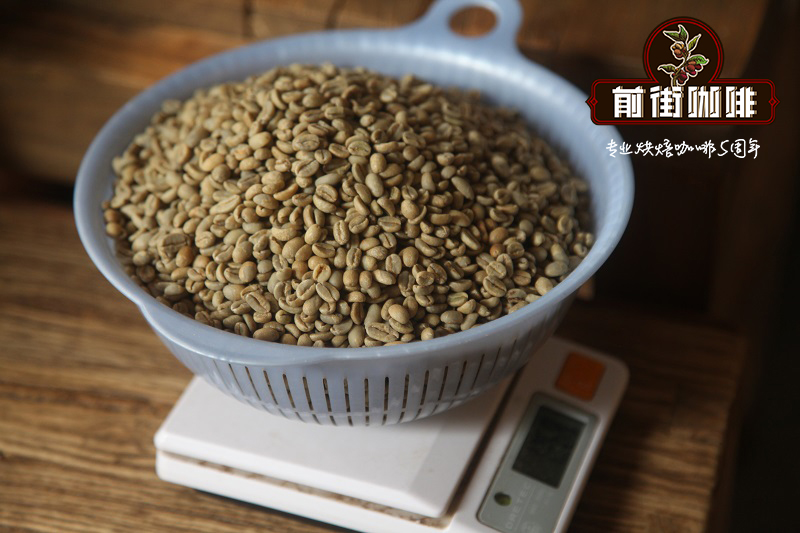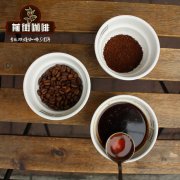How do you grow coffee beans? What kind of planting environment is needed for excellent coffee fruit? How to correct

Professional coffee knowledge exchange more coffee bean information please follow the coffee workshop (Wechat official account cafe_style)
How do you grow coffee beans? What kind of planting environment is needed for excellent coffee fruit? How to cultivate and plant correctly?
Due to the physiological characteristics of coffee trees, there are limited areas in the world that can cultivate coffee beans commercially. It is mainly limited by temperature, because coffee trees are vulnerable to frost. Therefore, neither the north nor the south latitude is suitable for planting, and it is suitable for tropical areas. When growing coffee trees in the tropics, you should pay special attention to the altitude. The closer you are to the equator, the more you can plant in the mountains at higher elevations, such as at 2500 Michael. It is difficult for coffee trees to endure high temperatures above 30 °C, especially in low humidity areas. Rainfall should also be appropriate, generally speaking, the appropriate annual rainfall is 1500 mm, but in some areas, the annual rainfall is as high as 2500 mm in order to grow good quality coffee beans, which is mainly due to the quality of the soil.
Although the coffee tree is called a tree, it is actually an evergreen shrub. If it is not trimmed, it can be as high as 3muri 9m. There is a glossy dark green at the top of the leaf and a dull light green at the bottom. The leaves are 7.5 mm long and 15 cm in length, which is opposite. Many small white flowers can be seen when blooming, so the appearance of the coffee tree is snow white. The fragrant flowers wither after a few days.
And small berries begin to develop. The color changes from dark green to deep red when ripe, and the fruit ripens about 7 months after flowering. Under the skin of the fruit, there is fleshy pulp, which is covered with a sheepskin-like skin (parchment skin), which is usually wrapped in two green coffee beans. Outside the beans is a fragile, close and almost transparent silver film (silver skin).
Coffee trees usually blossom once a year, but they may blossom more than once in rainy climates, as is the case with coffee in Taiwan. Flowers, green berries and ripe berries can often be seen on a tree at the same time. Coffee trees can usually be harvested within five years of planting, and can reach a good yield within eight years. Generally speaking, a considerable yield can be maintained within 20 years in 15mur. if the soil is in good and fertile condition, it can be extended to longer. Each seed produces an average of 0.5 to 0.7 kilograms of coffee beans per year, but it usually exceeds this number. Coffee trees generally need a stable environment, it can not resist frost, nor can it tolerate fairly high temperatures for a long time. And in areas with heavy rainfall, the varieties cultivated in alpine areas ranging from one thousand to three thousand meters above sea level are the best. Therefore, the tropical region and the temperate zone where coffee is suitable for cultivation in terms of climate and soil, that is, from about 28 degrees north latitude to 30 degrees south latitude, we call it the coffee zone (coffee zone). The following is a brief introduction to the natural conditions and planting procedures of coffee.
One of the characteristics of a coffee tree is that its fruit can bear fruit several times a year, and another is that flowers and fruits (also known as cherries) coexist at different stages of ripening. The style of the whole coffee industry is influenced by the fickle nature. If the fruit is too ripe, the beans in it will rot. If it is not ripe enough, the beans picked will not ripen by themselves. So bean pickers often go back to the same tree several times to look for ripe fruit-trying to get only 2 pounds of green coffee beans, usually an average of 2 pounds a year. Keep this in mind the next time you buy coffee.
There are also differences in the growth temperature of species. For example, the optimum temperature for Arabica coffee is 18 ℃-22 ℃, and that for Romsta coffee is 22-27 ℃. Brazil is the region with the largest coffee production in the world, and the annual average temperature of its cultivation land is 19-20 min. If the winter temperature is too low, the cultivation of coffee is difficult, or even die, because the low temperature often harms the development of young plants, and the harvest decreases, Arabica coffee is damaged if it is kept at a low temperature of 5 ℃ for several days, while extremely high temperatures lead to luxuriant branches and leaves and a decline in coffee quality. Therefore, in tropical high-temperature places, coffee is not planted in the lower Mid-levels (hillside), but not over the frost line (the lowest temperature is 0 ℃ line). Generally speaking, Arabica coffee grows between 600m above sea level and frost line, that is, between 600m and 2000 m. Romsta Coffee and Liberica Coffee are suitable for growing below 600 meters above sea level.
Climate:
The most suitable growth temperature is 15 °C-24 °C. if the temperature exceeds 25 °C, the photosynthesis will decrease, and if the high temperature lasts above 30 °C, the leaves will be damaged. It is suitable for growing in cool, shaded forests, such as the Ethiopian highlands, so high temperatures are the main limiting factor for growing coffee at low elevations. Coffee trees are very sensitive to frost damage, and other factors such as strong winds and low humidity are also disadvantageous. As far as rainfall is concerned, the appropriate annual rainfall is 1500Muth2500mm, preferably evenly distributed among the nine months, and the other three months are the dry season. In areas near the equator, such as Kenya, northern Tanzania and Colombia, there are two rainy and dry seasons, so they can harvest two crops a year.
Soil:
The most suitable soil is volcanic ash geology, followed by gneiss, sand, limestone, basalt and karst. The root of coffee tree has a great demand for oxygen, poor drainage and clayey soil are not suitable for planting. Sandy soil is also not suitable because it is impossible to conserve water. In dry areas, the soil should be highly water-holding and up to 2m deep. The PH quality of the soil is better in acidity, otherwise it needs to be improved, and the low nutrient soil should be fertilized properly.
The characteristic of Robusta coffee tree is that it is more suitable for growing in low altitude areas, can withstand higher temperature and more about Rain Water, needs more decaying soil, and has strong disease resistance.
Rainfall amount
The development of coffee needs sufficient moisture, and the annual rainfall should be at least 1000 mm, and the maximum should not exceed 3000 mm. The rainfall should not be excessive or moderate. If there is too much sauce for a time, or if there is no rain for a long time, the growth of coffee will be affected. But less rain in winter is good for harvest and growth. However, the need for coffee and water varies with the type. Arabica is more suitable for dry environment, while Romsta Coffee and Liberica can only be cultivated in warm and humid tropical climates.
Wind and sunshine
Wind is also one of the important factors in coffee cultivation. Arabian species and large-leaf coffee are afraid of wind damage by branches. Coffee cultivated in sandy land can uproot the trees or lodge them because of the strong wind after rain. when the coffee is fruited, it has been subjected to a storm and the harvest has been reduced. In addition, there is often a wind with salt in the seaside areas, which can hinder and damage the growth of coffee, and it will take a long time to recover, so the cultivation of coffee has been chosen to compare the Bifeng area or to set up windbreaks. In addition, in terms of sunshine, coffee grows under shaded conditions in the country of origin of Abyssinia, so planting taller shade trees in some areas (such as Africa, Java, and so on) has prevented short coffee trees from being directly exposed to sunlight. However, the need for shade trees has also been debated all over the world.
Topography and soil
Coffee is not strict with the soil, but the saline-alkali soil or strongly acidic soil near the sea is not suitable, but the gentle slope with deep soil layer and rich organic matter is the best, and the volcanic soil and newly reclaimed soil after deforestation are also suitable, and the clayey soil still has gravel. If the drainage is good, it is also worried about its growth. Romsta Coffee Coffee is sensitive to soil acidity, uncomfortable with coastal soil, and newly reclaimed land. The weathered soil of crushed granite grows better, while Arabica coffee is on the hillside and produces better quality coffee. The world's best coffee Blue Mountain Coffee (blue mountain) the best planting site, has been weathered granite soil, that is, on the slopes of Jamaica's extinct volcano area, the soil quality is superior, the climate is suitable, that is, the first choice of all conditions.
Cultivation mode
Breeding
Coffee breeding can be divided into sowing and asexual reproduction, generally speaking, the most economical cultivation still uses seed propagation, because it is simple and easy, and can obtain most seedlings, but Arabica flower multi-cross fertilization, its later generation type and quality is not fixed as a disadvantage. The following is a general description of coffee reproduction.
Seed propagation
The seeds used for coffee reproduction are mostly the seeds of asexual reproduction trees, the so-called asexual reproduction seeds, and it is appropriate to take fully mature seeds from the mother plants with older age, strong growth, rich yield and free of diseases and insect pests. As a seed fruit, it is best to remove the skin and flesh manually, because the use of machinery is often easy to damage the seed coat, and then after selection.
When sowing, earthen pots, wooden boxes or bamboo cages can be used when the amount of seed is small. If the quantity is large, choose the land with good drainage and fertile and loose quality, set up a seeding bed, the bed width is 1mi-1.4m, the distance between the sowing rows is 2m-5cm, germinate for 8 weeks after 5mi, and then transplant into a larger nursery when it grows into four leaflets, usually 1750 trees per hectare is enough.
Important Notice :
前街咖啡 FrontStreet Coffee has moved to new addredd:
FrontStreet Coffee Address: 315,Donghua East Road,GuangZhou
Tel:020 38364473
- Prev

What natural conditions are needed to grow high-quality coffee? How is the coffee fruit grown?
Professional coffee knowledge exchange more coffee bean information Please pay attention to the coffee workshop (Wechat official account cafe_style) what are the natural conditions for growing high-quality coffee fruit? How is the coffee fruit grown? Coffee tree, is a tropical plant, is an evergreen shrub, growing in the equator, latitude 25 degrees north and south, that is, within the Tropic of Cancer. North-South Hui
- Next

How to grow high-quality coffee bean seeds? What are the planting conditions that affect the growth of coffee beans?
Professional coffee knowledge exchange more coffee bean information please pay attention to the coffee workshop (Wechat official account cafe_style) how to grow high-quality coffee bean seeds? What are the planting conditions that affect the growth of coffee beans? Coffee beans are generally graded according to their size, defect rate and altitude. The size and defect rate of raw beans are easy to understand, and many people do not quite understand why some producing areas
Related
- Detailed explanation of Jadeite planting Land in Panamanian Jadeite Manor introduction to the grading system of Jadeite competitive bidding, Red bid, Green bid and Rose Summer
- Story of Coffee planting in Brenka region of Costa Rica Stonehenge Manor anaerobic heavy honey treatment of flavor mouth
- What's on the barrel of Blue Mountain Coffee beans?
- Can American coffee also pull flowers? How to use hot American style to pull out a good-looking pattern?
- Can you make a cold extract with coffee beans? What is the right proportion for cold-extracted coffee formula?
- Indonesian PWN Gold Mandrine Coffee Origin Features Flavor How to Chong? Mandolin coffee is American.
- A brief introduction to the flavor characteristics of Brazilian yellow bourbon coffee beans
- What is the effect of different water quality on the flavor of cold-extracted coffee? What kind of water is best for brewing coffee?
- Why do you think of Rose Summer whenever you mention Panamanian coffee?
- Introduction to the characteristics of authentic blue mountain coffee bean producing areas? What is the CIB Coffee Authority in Jamaica?

